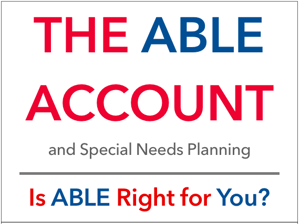Updated June 30, 2021
Reassessing Your ABLE Account Investment Choices

As part of an advisory group implementing the ABLE account in Massachusetts, we learned that many people opening ABLE accounts stopped the application process when they were asked to determine the investment choices for their contributions. This behavior raised a concern that individuals enrolling in the ABLE program might not have adequate prior experience or knowledge of financial matters to confidently make the best selection for their situation.
Depending on when you put funds in, your account may have increased in value or have taken a hit. For investors with little experience, it may be a shock to observe 90 cents where they had invested a dollar a short time earlier. Regardless of how much money is in the account, it is critical to invest the funds in the ABLE account to meet the goals of the account owner.
Key Considerations for Your Investment Choices
- When determining your asset allocation (the balance between stocks, bonds and money markets), think about your personal ability to withstand a decline in your account balance and your tolerance of market volatility .
- Be sure to align your asset allocation with the timing of your goals; the investments in the account should match how the account is being used.
Depending on the goals for the account, the funds may be invested to provide a mix between funding for transactions and growth for the future. For example, if a portion of the funds in the ABLE are to be used for transactions, you should consider investing these monies in very low risk assets, such as money market funds. Asset allocation should be a thoughtful and informed evaluation; federal law allows account owners to change investments in their ABLE account twice per year. Be sure you are comfortable that the money is invested to meet both your short-term needs and your long-term goals.
Case Study: Paul's ABLE Account Investment Choices
Paul and all other elements of this example are fictitious and all investment results are hypothetical.
Paul is an ABLE account owner. He works and has contributed about $5,000 of his earnings to his ABLE account over the course of the year. Paul was saving money in his ABLE to buy furniture for his apartment, and his parents decided to contribute $10,000 toward that goal to Paul’s ABLE account. Paul chose a growth portfolio for his ABLE, investing 70% in stocks and 25% in bonds and 5% in money market securities. At the end of the year, the stock market had taken a fall and the $15,000 contributed to the account over the course of the year was worth only $12,000 (market activity and return is hypothetical).
While Paul and his parents believe his account will recover the $3,000 loss over time, he has to rethink and/or postpone the furniture purchase he hoped to make in the spring. Since Paul had a near-term use for the funds he invested in his ABLE account, he needed to choose investments that may have offered a lower return but had little to no risk to this principal. He could have chosen the growth portfolio for a portion of the contributions and kept the remainder in another, more conservative fund or money market.
Like Paul, many individuals who have opened ABLE accounts may not be overly experienced with investments and should review and reassess their investment choices based upon the key considerations outlined above.
Content in this material is for general information only and not intended to provide specific advice or recommendations for any individual, nor intended to be a substitute for specific individualized tax or legal advice. We suggest that you discuss your specific situation with a qualified tax or legal advisor.
Prior to investing in an ABLE account investors should consider whether the investor's or designated beneficiary's home state offers any state tax or other benefits that are only available for investments in such state's ABLE program. Withdrawals used for qualified disability expenses are federally tax free. Tax treatment at the state level may vary.
Investing involves risk including loss of principal.
No strategy, including a diversified strategy, assures success or protects against loss.
Asset allocation does not ensure a profit or protect against a loss.




